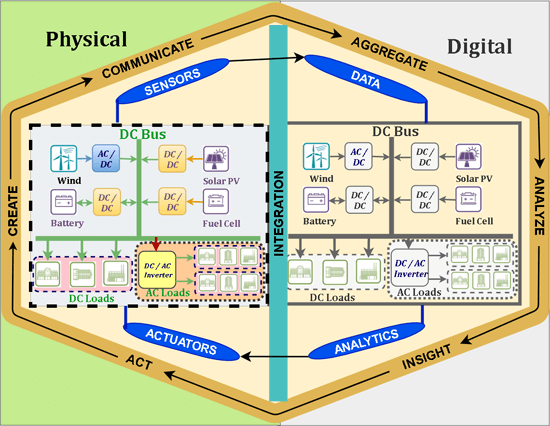Cyber Twin Approach for Smart Grids
By Karthikrajan Senthilnathan and Iyswarya Annapoorani K
In general, smart grids are the electric power networks aim to provide reliable and secured power supply to the consumer with advanced monitoring, control and communication systems. As a result of rapid growth in the field of cyber physical systems and smart grids, the cyber twin approach has a major role. The cyber twin model is a virtual model of the actual power network. The virtual model realizes the performance of the actual power system network. The cyber twin model helps the power distributor for analysing and prediction of the power network under various operating conditions.
Digital Twin for Smart Grid
As emerging technologies, Cyber Physical Systems (CPS) and Digital Twin (DT) referred as the integration of physical components and computational resources with bi-directional interaction. The DT consists of three components connected: Real physical target, Virtual target and Communication between physical and real targets.

Fig.1. Block diagram of Digital Twin for a micro grid
Fig.1. shows the block diagram of a microgrid with digital twin illustrating the operation of the digital twin. There are two loops in DT for physical and digital targets. The inner loops has sensors and actuators. The sensors collects the data from the physical target and transfers the data to the virtual target. The analytics computed from the digital target is transferred to the physical target through actuators for operation of the physical target.
For achieving the DT, six step procedure is followed:
Create: In create procedure, measurement of a physical target is carried out. The measurement is comprised of two categories: Operational measurement and Environmental measurement. In operational measurement, physical target measurement is carried out for instance voltage, current, frequency. In environmental measurement the temperature of the physical target and surrounding ambient temperature are transferred to digital signals for DT.
Communicate: The communication is the major part in DT for seamless integration for data transfer between physical and digital platforms. The three main components of communication are: (1) Edge Processing: The sensors, actuators form the physical and digital platform are connected through the edge interface connect. (2) Communication interfaces: It helps the information transfer form physical to digital platform and vice versa. (3) Edge security: The DT need high security for communications, the edge security provides the encryption, firewalls and application keys for the secured data transfer.
Aggregate: The data analytics processing is carried out by aggregating the information in real-time or cloud data. The data processing improves physical target performance and as well as physical process.
Analyse: The data gathered from the aggregator is used to analyse and visualize the data collected from the physical device. The data analysts and scientists analyse the data and make the improvements in the physical target for the intelligent decisions.
Insight: The data analysed are processed and it is visible to the user for visualization and identifying the differences. The digital platform processed the physical target and data visualized for performance monitoring and control of the target. The further investigation of the physical target is carried out by the insight of the data.
Act: The insight defines intelligent action to perform for physical target. The processed data form the digital platform triggered the actuators for the control. The back-end process is carried out by digital platform. Decoders and actuators control the physical target. The closed loop architecture of the physical and digital platform is carried out by the integration of the system and acts as steps to complete the process.
In smart grids, voltage, current, frequency data collected from the physical targets (actual grid) and computation is processed in virtual targets (virtual grid). The control of grid is performed with intelligent decision making by DT.
For a downloadable copy of November 2019 eNewsletter which includes this article, please visit the IEEE Smart Grid Resource Center.

Karthikrajan Senthilnathan received B.E. in Electrical and Electronics Engineering and M.E. in power systems engineering from Anna University, India, in 2012 and 2014, respectively. He is currently a Ph.D. student in electrical engineering at Vellore Institute of Technology, Chennai, India. His research interests are back to back converters, cyber physical systems, smart grids, Renewable energy Integration.

Iyswarya Annapoorani K is an associate professor at the School of Electrical Engineering, Vellore Institute of Technology, Chennai, India. She completed a PhD on High voltage engineering. Her research led to a number of academic publications and presentations. Her main research interests include high voltage, back to back converters, smart grids, renewable energy system modelling and power system stability and control.
To have the Bulletin delivered monthly to your inbox, join the IEEE Smart Grid Community.
Past Issues
To view archived articles, and issues, which deliver rich insight into the forces shaping the future of the smart grid. Older Bulletins (formerly eNewsletter) can be found here. To download full issues, visit the publications section of the IEEE Smart Grid Resource Center.




